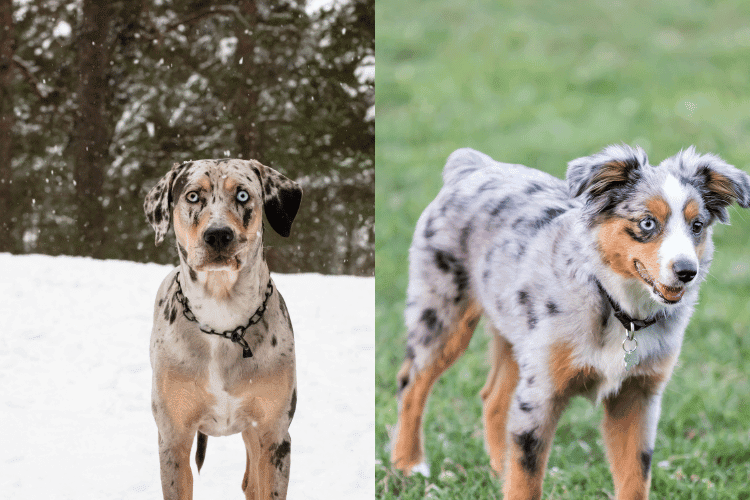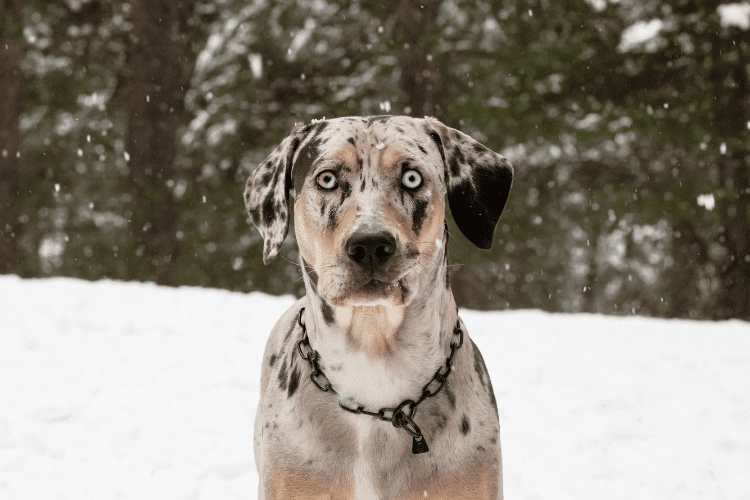Merle is a dominant gene responsible for altering pigmentation patterns in canines. Thanks to this gene, the Louisiana Catahoula breed is a head-turner, regardless of the coat color.
Some people could adopt a merle Catahoula Leopard dog for his attractive coat and unique eye color. However, there are some health implications to keep in mind.

Common Coat Colors and Patterns for a Merle Catahoula
If you have a Catahoula, you might notice that his coat doesn’t follow a specific pattern. After all, the merle genes are notorious for being unpredictable.
The coat pattern can range from irregular patches with diluted pigment to fully pigmented patches. Plus, there are many types to consider, such as non-merle, single-merle, and double-merle dogs.
Deciphering the possible genotypes and phenotypes in the breed isn’t always easy. If you’re trying to understand more about the Catahoula breed’s appearance, odds are, you’ll hear complex terminologies along the way.
Here’s a guide to help you pin down the merle type based on the Catahoula dog’s coat color.
Red Merle Catahoula Leopard
One of the most common colors among the merle Catahoula dogs is red. So, these pooches are single-merles with reddish-brown or liver coats.
Other red merle Leopards have a tight-skinned coat in a shade of tan, with darker brown patches all over their body. Some patches can be brindle or white trimmed.
Blue Merle Catahoula Leopard
The blue merle is another common single-merle Catahoula coat.

If your dog is a blue merle, his coat will range from light gray to pitch black. The patterns may vary, but you’ll find the familiar black patches scattered throughout his body.
Keep in mind that some people might refer to this case as the “gray leopard” or the “black leopard.”
Silver Merle Catahoula Leopard
The silver merle is yet another single-merle coat with patches that are a mottled color of black or dark brown.
This color pattern is similar to the blue merle. However, there’s a slight difference since the coat is lighter and looks like a diluted shade of blue.
Phantom Merle Catahoula Leopard
Some people call phantom merles “ghost merles” or “cryptic merles.”
Generally speaking, this term refers to Catahoula dogs that are genetically merle but appear to have a solid color.
That said, some people mistakenly label Catahoula dogs as phantom merles, only to find that they’re single merles upon closer inspection. In reality, the leopard spots and the glass eyes might just be doing a great job of hiding!
Chances are, the pup’s coat grew darker as he matured over time. All in all, a true phantom merle has had no visible evidence of patches or glass eyes since puppyhood.
Unfortunately, the only way you can detect a phantom merle is through DNA testing. So, you can’t really say for sure just by examining your pet’s coat.
Currently, the term “cryptic merle” describes a merle variant that’s phenotypically identical to a solid color.
Double Merle Catahoula Leopard
Each merle’s coat color and pattern are unique. Yet, things can get a bit confusing if you see a Catahoula dog that’s mostly or purely white.
Here’s where the double-merle gene comes in.
When you breed two adult merle dogs, the puppy can inherit two merle genes. As a result, he’ll have predominantly white fur.
If you spot a double-merle Catahoula pup, you can also expect to see a rosy-pink nose and light-colored paw pads. However, the dog may have a few patches of mottled light coloring on his back or the top of his head.
While this appearance is absolutely adorable, it’s important to remember that there is a risk in breeding double-merle dogs.
The Dangers of Merle-to-Merle Breeding
More often than we’d like, a double-merle dog with a white coat ends up having some hereditary defects. These defects can show up as problems in the skeletal, cardiac, and reproductive systems.
Not only does having double merle modify your Catahoula’s coat, but it could also affect his eyes and hearing capabilities. For one, you can expect quite a few auditory and ophthalmologic defects with merle dogs.
Because of the lack of normal pigmentation, double merles are prone to being blind, deaf, or both. That’s why some people discourage breeding merle-to-merle dogs.
Relative Breed Risk for Catahoulas
While there’s always a looming risk, many double-merle dogs with both defects can produce healthy litters without serious complications.

As it happens, the Catahoula Leopard dogs are a fine example of this.
For instance, double-merle Catahoula dogs have a lower risk of inheriting auditory impairment than double merles of other breeds. This is particularly true if you compare the Catahoula to the Australian Shepherd, the Shetland Sheepdog, or the Collie.
However, the reasons behind this discrepancy among breeds aren’t clear just yet.
Responsible Breeding for Merle Catahoulas
Either way, you shouldn’t abuse the fact that the double-merle Catahoula Leopard dogs aren’t very prone to inheriting defects. After all, breeding merles together can be wildly unpredictable and isn’t the safest way of producing puppies.
So, reliable breeders might need to DNA test their merle Catahoula dogs before mating them. This can help reduce the health risks in the litter.
The Different Merle Catahoula Eyes
We’ve mentioned glass eyes before, and merle Catahoula dogs commonly have this trait, but what exactly does this mean?
Well, there’s more than one type of eyes that your merle Catahoula can sport, including:
- Glass eyes or double glass
- One brown and one glass
- Cracked or marbled glass
- Double brown
- Amber eyes
- Heterochromatic eyes
So, your Catahoula might have “glass eyes” or “double glass eyes,” which are ice blue or strikingly blue-white. These “glass eyes” are very iconic aspects of the merle Catahoula Leopard dogs.
Meanwhile, some people might notice dark spots in their Catahoula dogs’ icy blue eyes. This means the pups have “cracked glass” or “marbled glass.”
The term “heterochromatic” eyes, on the other hand, refers to mismatched pairs. For instance, one of the dog’s eyes can be amber, while the other could be dark brown.

Calvin is the co-founder and one of the main contributors to dogtemperament.com. He has been an avid dog lover all his life. He enjoys researching and sharing great ideas on how you can avoid common pitfalls of dog ownership and build the most loving and enjoyable relationship with your dog.
Looking for a Dog Breed Price that Meets Your Budget?
Check out our